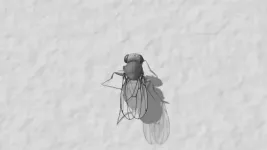(Press-News.org) While combing through the human genome in 2007, computational geneticist Pardis Sabeti made a discovery that would transform her research career. As a then postdoctoral fellow at the Broad Institute of MIT and Harvard, Sabeti discovered potential evidence that some unknown mutation in a gene called LARGE1 had a beneficial effect in the Nigerian population. Other scientists had discovered that this gene was critical for the Lassa virus to enter cells. Sabeti wondered whether a mutation in LARGE1 might prevent Lassa fever — an infection that is caused by the Lassa virus, is endemic in West Africa, and can be deadly in some people while only mild in others.
To find out, Sabeti decided later in 2007, as a new faculty member at Harvard University, that one of the first projects her new lab at the Broad would take on would be a genome-wide association study (GWAS) of Lassa susceptibility. She reached out to her collaborator Christian Happi, now the Director of the African Center of Excellence for Genomics of Infectious Diseases (ACEGID) at Redeemer’s University in Nigeria, and together they launched the study.
Now, their groups and collaborators report the results of that study in Nature Microbiology — the first ever GWAS of a biosafety level 4 (BSL-4) virus. The team found two key human genetic factors that could help explain why some people develop severe Lassa fever, and a set of LARGE1 variants linked to a reduced chance of getting Lassa fever. The work could lay the foundation for better treatments for Lassa fever and other similar diseases. The scientists are already working on a similar genetics study of Ebola susceptibility.
The paper also describes the many challenges the team had to overcome during their 16-year collaborative effort, such as studying a dangerous virus and recruiting patients with a disease that is not well documented in West Africa. Dozens of scientists contributed to the work and spent seven years recruiting patients in Nigeria and Sierra Leone and many additional years establishing the research program and analyzing the results. “It truly took a village to get this done,” said Happi, a co-senior author along with Sabeti.
“Generations of people in our labs, across different institutions and countries, spent significant parts of their careers bringing this to fruition,” added Sabeti, an institute member at the Broad, a Howard Hughes Medical Institute investigator, a professor at the Center for Systems Biology and the Department of Organismic and Evolutionary Biology at Harvard University, and a professor in the Department of Immunology and Infectious Disease at the Harvard T. H. Chan School of Public Health.
The co-first authors of the study are Dylan Kotliar, an internal medicine resident at Brigham and Women’s Hospital and an MD/PhD student in Sabeti’s lab while the project was ongoing; Siddharth Raju, a graduate student in Sabeti’s lab; Shervin Tabrizi, a postdoctoral researcher at the Broad; and Ikponmwosa Odia, a researcher at Irrua Specialist Teaching Hospital in Nigeria.
Lassa learnings
Sabeti recalls the team’s early discussions when launching the project. They knew they had to be cautious at every step: To work with a BSL-4 virus, scientists must wear pressurized suits connected to HEPA-filtered air in a special containment lab. The virus causes fever, sore throat, coughing, and vomiting, but can quickly progress to organ failure in some people.
“This was an extremely challenging study to get off the ground,” said Kotliar, who worked on the project throughout his entire PhD in the Sabeti lab. “I think the battle scars, the things we’ve learned along the way about how to get a project like this done, are going to be important for future research into viruses in developing countries.”
Finding participants for the study would be challenging too. There are currently no FDA-approved diagnostics for Lassa, and Lassa virus cases are typically not documented. There are fewer than 1,000 cases reported each year in Nigeria, the most populous country where the virus is endemic, and cases are often in rural areas far from diagnostic centers, many of which don’t have the technology to detect the virus. Infections with other viruses, and genomic complexity among different strains of the same Lassa virus can complicate analysis. Moreover, African populations have been historically underrepresented in past genetic studies, which reduces statistical power in data analyses and can make it difficult to identify key genetic variants.
When Sabeti began thinking about how to start the project, she reached out to Happi, whom she knew through their mutual work on the malaria-causing pathogen, Plasmodium falciparum. With the help of collaborators including Peter Okokhere, a doctor treating Lassa patients at the Irrua Specialist Teaching Hospital, they began recruiting patients from both Nigeria and Sierra Leone. Then, they compared the genomes of about 500 people who’d had Lassa fever and nearly 2,000 who hadn’t.
In the Nigerian cohort, the team found that people with a set of variants in the LARGE1 gene — which modifies a cell receptor that binds to certain viruses — were less likely to get Lassa fever. Sabeti, Happi, and their colleagues also found genomic regions associated with Lassa fatality: in the LIF1 gene, which encodes an immune-signaling molecule, and, in the Nigerian cohort, the GRM7 gene, which is involved in the central nervous system. The team then used a large-scale screen called a massively parallel reporter assay to home in on which variants within these genomic regions might be functional and could be targets of new treatments.
Better detection
The researchers say that to improve detection and treatment of Lassa fever, more diagnostic centers and diagnostics that work in the field are needed, along with better health infrastructure to connect remote locations with major hospitals.
“This really highlights the need for continued investment in understanding African population genetics,” added Raju. “Even with a relatively limited sample set, we’ve increased our understanding of some African populations, specifically in immune-related genes — and that shows how much more there is to do going forward.”
Sixteen years after they first started thinking about the genetics of Lassa fever, Sabeti and Happi are excited about the study’s findings, which could explain the biological differences between mild and severe illness. They said the work also shows that, as thoughtful collaborations between countries, genome-wide association studies of BSL-4 viruses are possible. The researchers have already begun conducting a similar study of Ebola in Sierra Leone and Liberia, and other scientists are calling for increased pathogen surveillance and scientific training in Africa.
“We’re standing at a moment where we can actually start developing point-of-need diagnostics for Lassa virus and testing much more broadly,” Happi said. “We need better infrastructure, but I think we’ve shown that this kind of study is a worthwhile pursuit.”
Funding:
This work was supported in part by the National Institute of Health, the German Research Foundation, and the Howard Hughes Medical Institute.
Paper cited:
Kotliar DK, Raju S, Tabrizi S, Odia I, et al. Genome-wide association study identifies human genetic variants associated with fatal outcome from Lassa fever. Nature Microbiology. Online February 7, 2024. DOI: 10.1038/s41564-023-01589-3.
About Broad Institute of MIT and Harvard
Broad Institute of MIT and Harvard was launched in 2004 to empower this generation of creative scientists to transform medicine. The Broad Institute seeks to describe the molecular components of life and their connections; discover the molecular basis of major human diseases; develop effective new approaches to diagnostics and therapeutics; and disseminate discoveries, tools, methods and data openly to the entire scientific community.
Founded by MIT, Harvard, Harvard-affiliated hospitals, and the visionary Los Angeles philanthropists Eli and Edythe L. Broad, the Broad Institute includes faculty, professional staff and students from throughout the MIT and Harvard biomedical research communities and beyond, with collaborations spanning over a hundred private and public institutions in more than 40 countries worldwide.
END
Researchers uncover genetic factors for severe Lassa fever
New findings from an international collaboration pave the way for studies of highly infectious diseases in Africa such as Ebola.
2024-02-08
ELSE PRESS RELEASES FROM THIS DATE:
Leader in robotics at U-M and beyond elected to National Academy of Engineering
2024-02-08
Feb. 8, 2024
Contact: Katherine McAlpine, 734-647-7087, kmca@umich.edu
Image
Leader in robotics at U-M and beyond elected to National Academy of Engineering
Dawn Tilbury is recognized for advances in manufacturing network control and human-robot interaction, as well as engineering leadership
ANN ARBOR—Dawn Tilbury, the Ronald D. and Regina C. McNeil Department Chair of Robotics at the University of Michigan, has been recognized with one of engineering's greatest honors—election to the National Academy of Engineering.
NAE members are outstanding researchers, ...
16 UTA scholars receive McNair federal research award
2024-02-08
A competitive U.S. Department of Education program that prepares undergraduate students interested in careers in academic research has selected 16 undergraduate students from The University of Texas at Arlington to join.
The McNair Scholars Program was named for physicist and astronaut Ronald E. McNair, the second Black astronaut in U.S. history and one of several crew members killed when the space shuttle Challenger exploded on Jan. 28, 1986. The program assists qualified first-generation ...
Nanofiber bandages fight infection, speed healing
2024-02-08
ITHACA, N.Y. – Cornell University researchers have identified a new way to harness the antioxidant and antibacterial properties of a botanical compound to make nanofiber-coated cotton bandages that fight infection and help wounds heal more quickly.
The findings are especially important given the increasing prevalence of multidrug-resistant bacteria.
Cotton gauze is one of the most common wound dressings; it’s inexpensive, readily available, comfortable and biocompatible. However, it doesn’t promote healing or fight infection.
“Cotton alone cannot provide an answer for these ...
Newly discovered genetic malfunction causes rare lung disease
2024-02-08
The macrophage is one of the body’s most important inhabitants. Meaning “big eater” in Greek, this immune cell consumes and digests problematic elements from microbes and cancer cells to dust and debris. Macrophages are especially important in the lungs, where they both fight bacterial infection and clear the lungs of excess surfactant, a protein- and lipid-rich layer that’s essential to healthy function but can create a sticky buildup if not controlled.
In a recent study, investigators from Rockefeller University ...
Even with resolution, acute kidney injury in newborns can be life-threatening from very first episode
2024-02-08
Our resilient kidneys are invaluable members of the body’s purification system, and they excel at bouncing back after injury. This even holds true for most sick infants in the neonatal intensive care unit. Because of this remarkable ability, dips in kidney function in infants were often overlooked historically in favor of other pressing diseases or symptoms.
But physicians and researchers have shown increased interest in understanding kidney health in newborns and young infants within the last decade, leading to the AWAKEN study (Assessment of Worldwide Acute Kidney Epidemiology in Neonates). With initial ...
High-profile incidents of police brutality sway public opinion more than performance of people’s local law enforcement, new study from NYU Tandon reveals
2024-02-08
National media coverage of police brutality influences public perceptions of law enforcement more than the performance of people’s local police departments, according to data analysis from NYU Tandon School of Engineering, challenging the assumption that public confidence in police depends mostly on feeling safe from local crime.
In a study published in Communications Psychology, a NYU Tandon research team tracked media coverage of police brutality in 18 metropolitan areas in the United States – along with coverage of local crimes – and analyzed tweets from those cities to tease out positive attitudes from negative ...
Why politics bring out the worst in us
2024-02-08
Tap into any social media platform, turn on the television or cue up a podcast, and it is easy to find examples of hypocrisy or bad behavior in political discourse, and new research from University of Nebraska–Lincoln political scientists may explain why.
The findings from a large survey study, co-authored by Kyle Hull, Kevin Smith and Clarisse Warren, demonstrate the willingness of people to bend their morals — even behave unethically — when engaging in the political realm.
Results also suggest that hostility toward outgroups (i.e., opposing party) is the driving factor for the moral ambiguity exercised ...
How fruit flies control the brain's "steering wheel"
2024-02-08
When we walk down the street, we have an internal sense of which way we are heading, from looking at street signals and physical landmarks, and also a sense of where we’d like to go. But how does the brain coordinate between these directions, doing the mental math that tells us which way to turn?
Now, new research describes such a neural process in fruit flies, providing insight into how an animal’s brain steers it in the right direction. The study, published in Nature , shows how neurons that signal the direction in which a fly is currently oriented work together with neurons that signal the direction in which way the ...
SwRI’s Dr. Alan Stern named AIAA Fellow
2024-02-08
SAN ANTONIO — February 8, 2024 —Dr. Alan Stern, a planetary scientist and associate vice president of Southwest Research Institute’s Space Sector, has been named a Fellow of the American Institute of Aeronautics and Astronautics (AIAA). Fellows are recognized for their notable and valuable contributions to the arts, sciences or technology of aeronautics and astronautics. AIAA cited Stern “for outstanding contributions to the exploration of the solar system and the development of commercial spaceflight.”
“I am honored beyond words to be named an AIAA Fellow and thank my nominators very much, including SwRI Vice President Dr. Ben Thacker, who led the nomination,” ...
Visualising multiple sclerosis with a new MRI procedure
2024-02-08
Multiple sclerosis (MS) is a neurological disease that usually leads to permanent disabilities. It affects around 2.9 million people worldwide, and around 15,000 in Switzerland alone. One key feature of the disease is that it causes the patient’s own immune system to attack and destroy the myelin sheaths in the central nervous system. These protective sheaths insulate the nerve fibres, much like the plastic coating around a copper wire. Myelin sheaths ensure that electrical impulses travel quickly and efficiently from nerve cell to nerve cell. If they are damaged or become thinner, this can lead to irreversible visual, ...
LAST 30 PRESS RELEASES:
Injectable breast ‘implant’ offers alternative to traditional surgeries
Neuroscientists devise formulas to measure multilingualism
New prostate cancer trial seeks to reduce toxicity without sacrificing efficacy
Geometry shapes life
A CRISPR screen reveals many previously unrecognized genes required for brain development and a new neurodevelopmental disorder
Hot flush treatment has anti-breast cancer activity, study finds
Securing AI systems against growing cybersecurity threats
Longest observation of an active solar region
Why nail-biting, procrastination and other self-sabotaging behaviors are rooted in survival instincts
Regional variations in mechanical properties of porcine leptomeninges
Artificial empathy in therapy and healthcare: advancements in interpersonal interaction technologies
Why some brains switch gears more efficiently than others
UVA’s Jundong Li wins ICDM’S 2025 Tao Li Award for data mining, machine learning
UVA’s low-power, high-performance computer power player Mircea Stan earns National Academy of Inventors fellowship
Not playing by the rules: USU researcher explores filamentous algae dynamics in rivers
Do our body clocks influence our risk of dementia?
Anthropologists offer new evidence of bipedalism in long-debated fossil discovery
Safer receipt paper from wood
Dosage-sensitive genes suggest no whole-genome duplications in ancestral angiosperm
First ancient human herpesvirus genomes document their deep history with humans
Why Some Bacteria Survive Antibiotics and How to Stop Them - New study reveals that bacteria can survive antibiotic treatment through two fundamentally different “shutdown modes”
UCLA study links scar healing to dangerous placenta condition
CHANGE-seq-BE finds off-target changes in the genome from base editors
The Journal of Nuclear Medicine Ahead-of-Print Tip Sheet: January 2, 2026
Delayed or absent first dose of measles, mumps, and rubella vaccination
Trends in US preterm birth rates by household income and race and ethnicity
Study identifies potential biomarker linked to progression and brain inflammation in multiple sclerosis
Many mothers in Norway do not show up for postnatal check-ups
Researchers want to find out why quick clay is so unstable
Superradiant spins show teamwork at the quantum scale
[Press-News.org] Researchers uncover genetic factors for severe Lassa feverNew findings from an international collaboration pave the way for studies of highly infectious diseases in Africa such as Ebola.





